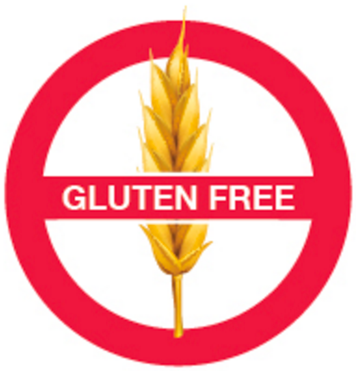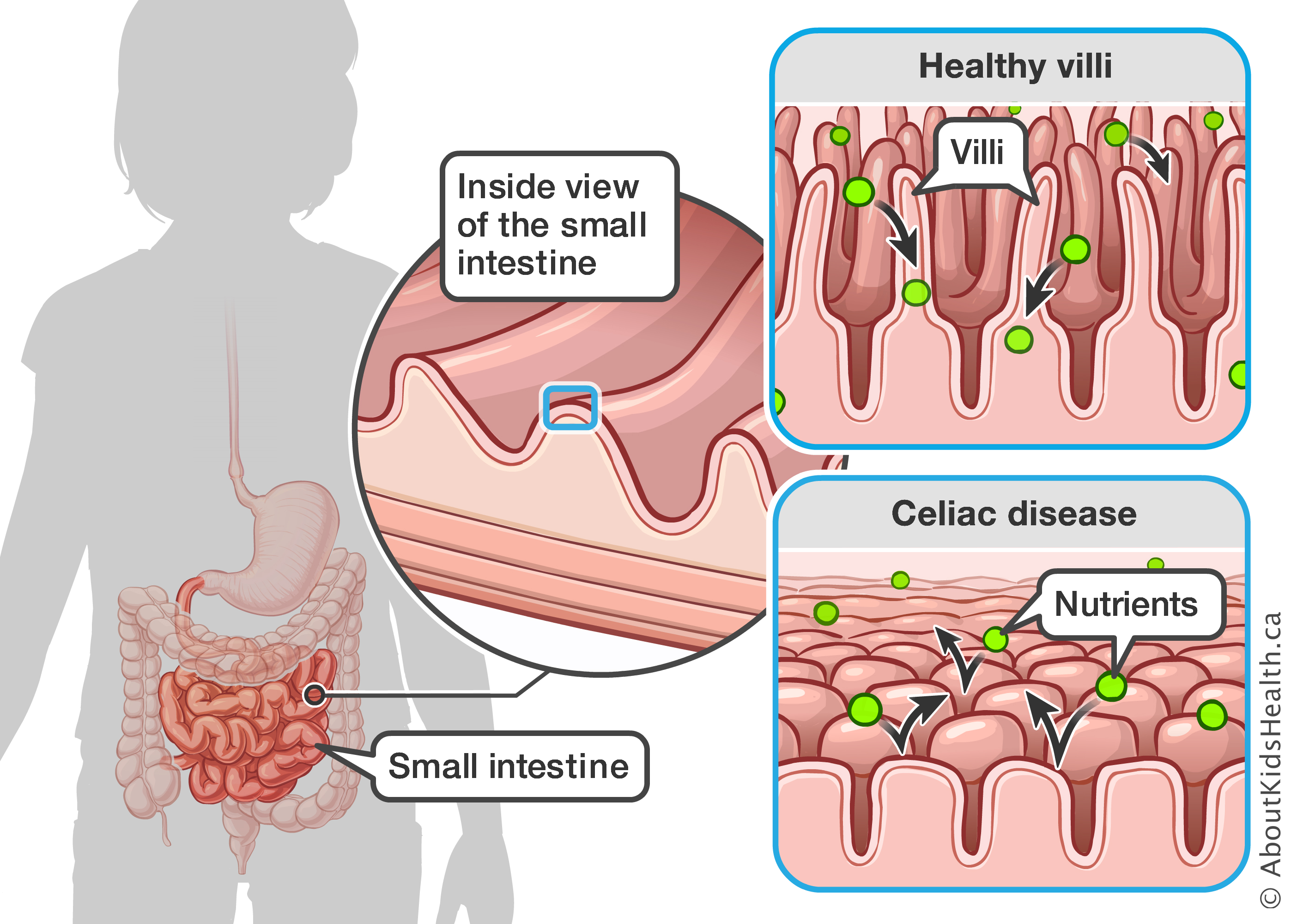What is celiac disease?
Celiac disease is an autoimmune condition in which contact with gluten (a family of food proteins) triggers a reaction by the body’s defense (immune) system. The immune response to gluten—no matter where in the body the contact happened—damages the lining of the gut (small intestine) making it difficult to absorb nutrients.
Common symptoms of celiac disease include
diarrhea,
constipation,
headaches, tiredness and anemia. Some people experience no symptoms at all.
Celiac disease is a life-long condition. There is no medication for celiac disease. The only treatment is a strict gluten-free diet for life. The gluten-free diet will help heal the gut, improve symptoms that may have been present, and keep your child healthy.

What is the gluten-free diet?
A strict gluten-free diet means no trace amounts of gluten. Gluten is naturally found in all forms of:
- wheat
- rye
- barley
- triticale (rye and barley mix).
Wheat-based products, such as breads, pasta and baked goods, are obvious sources of gluten. However, there are also many foods where gluten is hidden, such as soups, salad dressings and ice creams.
Always read the labels of all foods and non-food items (such as medications) to find out if they contain any sources of gluten.
How to avoid cross-contamination
Cross-contamination occurs when gluten is not intentionally (not on purpose) transferred from one food or object to another food or object. It is important to avoid all sources of cross-contamination.
At home
Washing:
- Wash hands between handling gluten-containing and gluten-free foods.
- Wash hands and toys that have been contaminated with gluten.
- Wash the counters carefully before preparing a gluten-free meal.
- Clean all pots, pans, utensils and counter tops with soap between uses.
In the kitchen:
- Keep gluten-free foods separated from foods that contain gluten.
- Use a separate toaster, grill, colander and cutting board for all gluten-free products. If you use your grill for foods that contain gluten, wrap the gluten-free item in foil before cooking.
- Use plastic or metal baking utensils and cutting boards instead of wooden ones because gluten sticks to wood.
- Use condiments from a squeeze bottle when available or have separate containers for those used with gluten-free products (for example, butter or margarine dish).
Avoid foods potentially contaminated with gluten:
- Do not buy foods that have no nutrition or allergy information on the label.
- Do not eat gluten-free foods that are on the same plate as gluten-containing food (for example trays with fruits, cheese and gluten-containing crackers).
Outside of the home
You have no control over your environment when you and your family are outside your home. Keep in mind that:
- Toys and play surfaces at day cares, school or others’ homes may be contaminated with gluten. Avoid touching or placing your child’s food on these surfaces.
- Do not buy foods from bulk bins. Products in bulk bins can become contaminated when scoops are used in more than one bin. There is no assurance that the other customers will be as cautious as you.
- Do not buy foods from stores where no nutrition or allergy information are on the label. This may happen with foods imported from other countries.
- Contact food companies when in doubt about processing and gluten contamination.
- Choose packaged deli meats. At the deli counter gluten-free meats are cut using the same slicer without cleaning between uses, which is a source of contamination.
- Avoid buffets as foods may become contaminated with gluten when customers use the same serving utensils between dishes.
- Avoid french fries and other gluten-free foods if they have been cooked in oil which has been contaminated with gluten. This may be the case if battered foods or seasoned foods have been fried in the same fryer.
- Meat can become contaminated if it is cooked on a grill which is also used to cook gluten-containing foods.
At school
- Speak to your child’s school about the need for your child to be on a strict gluten-free diet.
- Ask the school about gluten-free menu options. It is important to check directly with the food provider about potential sources of contamination.
- Make sure your child understands why they should not trade food with other students.
Before going out to eat
Call the restaurant beforehand. Tell them that your child’s gluten-free diet is medical treatment for celiac disease, and not an intolerance or sensitivity.
Visit the restaurant’s website to check its menu, list of ingredients and allergy warnings.
Select a restaurant where communication will be easy and where the specifics of the strict gluten-free diet will be understood. For example, you should make sure that language will not be a barrier to communication.
If you do not have time to call ahead, inform your server and the chef of the strict gluten-free diet when you arrive. Try to go to restaurants during hours when it is less busy. With more time, restaurant staff may have more resources to focus on the specifics of the strict gluten-free diet.
Bring gluten-free breads, crackers and favourite condiments—including salad dressing—to the restaurant.
At the restaurant
Remember to always ask about cross-contamination. You may want to explain what cross-contamination is. You can say, “Cross-contamination happens when gluten from one food or object comes in contact with another food or object.” Ask for food to be prepared on clean surfaces with clean utensils and gloves.
Avoid all seasonings, sauces (for instance soy sauce), croutons, soups and gravies. Be specific when ordering. You can say “I want no gravy on my plate.”
Ask what food is deep fried in the same oil or fryer. You can explain that french fries, tofu, nachos and wings cooked in the same oil as nuggets or onion rings (which are sources of gluten) will be cross-contaminated and are unsafe for your child.
Ask for allergy or nutrition information lists.
Avoid buffets.
Tips for calling food companies
Finding contact information
If you are not sure about a food product or an ingredient in a non-food product, call the company. Find and write down or take a picture of the contact information for the company from the package. In Canada, this is usually a 1-800 phone number.
If you cannot find a contact phone number, record the name of the company. You can look for the company’s name in the phonebook or search for the contact information on the Internet.
Record the name of the product and the UPC code number; this is the number at the bottom of the bar code.
What to ask
Call the company and ask to speak with customer service. Ask specific questions about the product, such as “Is this product gluten-free?” or “Does the product contain oats, barley, wheat, rye, triticale, or any components of these ingredients?”
If the company is unable to confirm that the product is gluten-free, then do not eat or use that product. Remember that ingredient lists change and you may need to update this information at a later date.
Some companies maintain a list of products that are considered “gluten-free”. The company can send you the list at your request. Some companies list gluten-free information on their website. Make sure that the information has been recently updated (within the last year).
Tax credit
The purchase of gluten-free products for a person with celiac disease is considered a medical expense and can be filed as such with your taxes with Canada Revenue Agency. You will be required to have the following documentation:
- a letter from a health-care practitioner certifying that the person requires gluten-free products due to celiac disease
- a summary of each item purchased during the 12-month period for which the expenses are being claimed
- a receipt to support the cost of each gluten-free product claimed
For more information, visit the Canada Revenue Agency website.
Resources
Websites
The Canadian Celiac Association and its local chapters offer many resources to help maintain a gluten-free diet and more.
The Gluten-Free Certification Program provides information about gluten-free products that are safe to eat for people with celiac disease.
Handbook
Acceptability of Foods and Food Ingredients for Gluten-free Diets is a pocket dictionary published by the Canadian Celiac Association. It references food ingredients and additives under "allowed" or "not allowed" categories to guide people on gluten-free diets.
App
Acceptability of Foods and Food Ingredients for Gluten-free Diets pocket dictionary is also available as an iTunes application. Search “Gluten free 247” for the version created by the Canadian Celiac Association.
Other apps to help manage celiac disease are available. Check each app review and ask other families for their opinion to choose an app best suited for your needs.
Books
Celiac disease
- Managing Diabetes and Celiac Disease Together, by the Canadian Celiac Association
- Gluten-Free Diet: A Comprehensive Resource Guide, by Shelley Case
Children’s books
- Growing up Celiac, by the Canadian Celiac Association
- Eating Gluten-Free with Emily: A Story for Children with Celiac Disease, by Bonnie J. Kruszka (5 year olds)
- No More Cupcakes and Tummy Aches: A Story for Parents and their Celiac Children to Share, by Jax Peters Lowell (3-8 year olds)
- Kids with Celiac Disease: A Family Guide to Raising Happy, Healthy, Gluten-Free Children, by Danna Korn
- The GF Kid: A Celiac Disease Survival Guide, by Melissa London (8-12 year olds)
Cook books
- Incredible Edible Gluten-Free Foods for Kids: 150 Family-tested recipes, by Sheri L. Sanderson
- Great Food Gluten Free, by Jeanette Mahoney
- Gluten Free on a Shoestring, by Nicole Hunn
- The How Can It Be Gluten Free Cookbook, by America’s Test Kitchen

